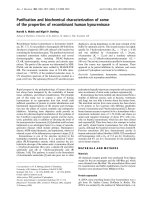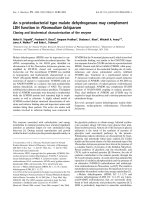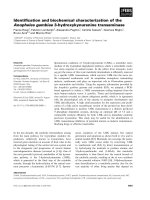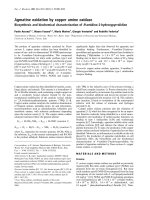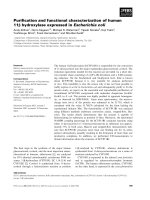Morphological and bio-chemical characterization of bael (Aegle marmelos Correa.) in West Garo Hills, Meghalaya, India
Bạn đang xem bản rút gọn của tài liệu. Xem và tải ngay bản đầy đủ của tài liệu tại đây (286.81 KB, 7 trang )
Int.J.Curr.Microbiol.App.Sci (2019) 8(10): 2414-2420
International Journal of Current Microbiology and Applied Sciences
ISSN: 2319-7706 Volume 8 Number 10 (2019)
Journal homepage:
Original Research Article
/>
Morphological and Bio-chemical Characterization of Bael (Aegle marmelos
Correa.) in West Garo Hills, Meghalaya, India
J. P. Lyngdoh Pale*, Sanjay Chetri, C. P. Suresh, Y. S. Singh,
A. Chaurasiya and A. Barman
Department of Horticulture, North-Eastern Hill University (N.E.H.U.), Chasingre, West Garo
Hills 794002, Meghalaya, India
*Corresponding author
ABSTRACT
Keywords
Morphological,
Biochemical,
Organoleptic, Aegle
marmelos,
Variability
Article Info
Accepted:
17 September 2019
Available Online:
10 October 2019
The present study entitled, “Morphological and Biochemical
Characterization of Bael (Aegle marmelos Correa.) in West Garo Hills,
Meghalaya” was carried out in Garo Hills of Meghalaya, India during
2017-2018 at Department of Horticulture, North Eastern Hill University,
Chasingre, Tura campus, in West Garo Hills Districts, Meghalaya. Thirty
different accessions of bael fruits were collected from different locations of
West Garo Hills and the analysis of variance was carried out in a
Completely Randomized Design with three replications. The result revealed
that significant variation in respect of their morphological and biochemical
characters. Based on the quantitative, biochemical and organoleptic
characters, accessions collected from location-3 i.e., Cherangre, location-5
i.e., Sampalgre and location-6 i.e., Babupara were found to be the best and
promising accessions.
Introduction
Bael (Aegle marmelos Correa.) also known as
Bengal quince, Bilva, Bilpatre, Maredu, Shul,
Vilvam, Shaiphal, etc., belongs to the family
Rutaceae. In Garo language, bael is called as
„Selfree‟. It is a subtropical plant which can
grow up to an altitude of 1200 m from the sea
level. The generic name „Aegle’ is of Greek
origin and the species „marmelos‟ is of
Portuguese origin. Aegle belong to one of the
three monotypic genera of orange sub family
Aurantioideae, tribe Clauseneae and sub-tribe
Balsamocitrinea (Nair and Barche, 2016). The
chromosome number 2n = 36. Bael can adapt
a wide range of habitat and can be cultivated
worldwide. It is native to India and has its
origin from Eastern Ghats and Central India.
In India, it is distributed throughout the
country but concentrated area under bael is in
2414
Int.J.Curr.Microbiol.App.Sci (2019) 8(10): 2414-2420
Eastern parts of the Gangetic plains and
nearby areas particularly in Uttar Pradesh,
Bihar, West Bengal and Orissa. It is also
available in wild form in sub-Himalayan tract
from Rajasthan to West Bengal, Central and
Southern India.
The bael fruit has been known in India from
prehistoric writings dating back to 800 B.C.
The leaves of the tree are traditionally used as
sacred offerings to "Lord Shiva," according to
Hindu customs. It is also called Shivadurme,
the tree of Shiva. According to Hindu
mythology, the tree is another form of Lord
Kailashnath. It is also sacred to Parvati and is
the Vilvarupra, one of the Patricas, or nine
forms of Goddess Kali (Sharma et al., 2007).
Bael is a nutritious and medicinal fruit, which
is most suitable for water scarce areas of the
country. Every part of the bael tree whether
stem, bark, root, leaves or fruit at different
maturity stages is utilized for various
purposes. It is used in the preparation of
several Ayurvedic medicines since ancient
times (Rai and Dwivedi, 1992). Marmelocin is
probably the therapeutically active factor of
bael fruit and is known as the „panaceae‟ of
the stomach ailments.
Materials and Methods
The present study entitled, “Morphological
and Biochemical Characterization of Bael
(Aegle marmelos Correa.) in West Garo Hills,
Meghalaya” was carried out in Garo Hills of
Meghalaya, India during 2017-2018 at the
Department of Horticulture, North Eastern
Hill University, Chasingre, Tura campus, in
West Garo Hills Districts, Meghalaya situated
approximately between the latitudes of 90⁰
30‟ and 89⁰ 40‟E, and the longitudes of 26⁰
and 25⁰ 20‟ N. Thirty different accessions of
bael fruits were collected from different
locations in West Garo Hills viz., location-1
i.e., Rongram, location-2 i.e., Rongkhon,
location-3 i.e., Cherangre, location-4 i.e.,
Reserve Gittim, location-5 i.e., Sampalgre,
location-6 i.e., Babupara, loation-7 i.e.,
Hawakhana, location-8 i.e., Sangsangre,
location-9 i.e., Dobasipara and location-10
i.e., Sunny Hills, and the analysis of variance
was carried out in a Completely Randomized
Design with three replications. The trees and
fruits characters collected from all the
locations
were
measured
for
their
morphological characters. The bio-chemical
characters of the fruits also was analysed
using the standard methods (AOAC 1990).
The organoleptic quality of the fruit pulp of all
the accessions collected from different
locations were distributed to a team of
panellist for overall acceptability that actually
included the point like colour, aroma/flavour,
taste and acridity on a 5.00 Point Hedonic
Scale (Amerine et al.,1965). The accessions
receiving high score in pulp colour, pulp taste,
pulp aroma, and low score in pulp acridity was
considered acceptable.
Statistical analysis
The test for significance was done by
following the method described by Panse and
Sukhatme (1967), while the method described
by Mahalanobis (1932) was followed for
Completely Randomized Block Design and
Factorial Completely Randomized Design.
The analysis of variance (ANOVA) of the data
was carried out by the techniques as suggested
by Ragharamula et al., (1983). Correlation
analysis was done by using SPSS Software
Version 16.0.
Results and Discussion
Morphological characters
The variations observed among the accessions
collected were recorded and presented in
Table 1. The highest tree height was recorded
from location-6 i.e., Babupara (8.67 m), while
2415
Int.J.Curr.Microbiol.App.Sci (2019) 8(10): 2414-2420
the lowest tree height from location-4 i.e.,
Reserve Gittim (5.67 m). The maximum trunk
girth was recorded from location-5 i.e.,
Sampalgre (132.03 cm), while the lowest
trunk girth was recorded from location-1 i.e.,
Rongram (66.13 cm). The maximum tree
spread in term of North-South direction was
recorded from location-8 i.e., Sangsangre
(7.62m) and the maximum tree spread in term
of East-West direction was recorded from
location-5 i.e., Sampalgre (6.81 m), the
minimum tree spread in term of both NorthSouth and East-West direction was recorded
from location-3 i.e., Cherangre (4.83 m) and
(3.57 m).
Similar finding were found by Patil et al.,
(2017); Simla et al., (2017), Kumar et al.,
(2014) and Goswami et al., (2011) while
working on the morphological characters of
the fruit crop, they found that there was a wide
variation in the tree height, width, tree spread
and number of fruits per tree.
Quantitative characters of the fruits
Significant variations were recorded from
among the accessions collected from different
locations and have been presented in Table 2.
Maximum fruit length was recorded from
location-5 i.e., Sampalgre (16.31cm), while
the lowest fruit length was noted in location-3
i.e., Cherangre (11.50cm). The accessions
collected from location-5 i.e., Sampalgre
recorded significantly maximum fruit width
(16.94cm), significantly highest fruit weight
(0.57 kg), significantly maximum pulp weight
(62.11g) and maximum number of seeds per
fruit (52.71). Location-3 i.e., Cherangre
recorded the minimum fruit length (11.50 cm),
significantly minimum fruit width (9.34 cm),
significantly lowest fruit weight (0.15kg),
minimum fruit skull thickness (2.19 mm),
significantly lowest pulp weight (31.66g),
significantly minimum numbers of fruits per
tree (14.33) and significantly minimum
number of seeds per fruit (31.57). Such
Similar findings with respect in this parameter
were reported by Singh et al., (2000); Lal
(2002); Shrivastava and Singh (2004); Saroj et
al., (2008); Pandey et al., (2008); Mitra et al.,
(2010); Pandey et al., (2013); Kumar and Nath
(2015); Uddin et al., (2016) and Nagar et al.,
(2017).
Bio-chemical characters
The variations observed among the accessions
collected have been presented in Table 3.
Significantly highest TSS (35.47 ⁰Brix) was
recorded from location-3 i.e., Cherangre,
while the lowest TSS (24.80⁰Brix) from
location-1 i.e., Rongram. The accessions
collected from location-3 i.e., Cherangre
recorded minimum titrable acidity (0.23 %)
and highest total sugars (25.38 The highest
reducing sugar was recorded from location-10
i.e., Sunny Hills (8.84 %), while the lowest
was recorded from location-9 i.e., Dobasipara
(4.69 %).
Lowest total sugars and non reducing sugars
was recorded from location-1 i.e., Rongram
(14.34 %) and (6.67 %). The highest titrable
acidity was recorded from location-7 i.e.,
Hawakhana (0.45 %). Earlier workers also
reported similar variation in these characters
Nagar et al., (2017); Kaur and Kalia (2017);
Uddin et al., (2016); Kumar and Nath (2015);
Singh et al., (2014a); Singh et al.,(2014); Ram
and Singh (2003) and Bhadre and Sen (1997).
Organoleptic characters
Pulp characters from the accessions collected
from different locations were recorded and
presented in Table 4. The highest pulp taste
was recorded from accessions from location-6
i.e., Babupara (3.34), while the lowest pulp
colour was recorded from location-3 i.e.,
Cherangre (2.90).
2416
Int.J.Curr.Microbiol.App.Sci (2019) 8(10): 2414-2420
Table.1 Morphological characters of the trees
Location
Tree height(m)
Truck
girth(cm)
L1-Rr
L2-Rk
L3-Cg
L4-Rg
L5-Sp
L6-Bp
L7-Hk
L8-Sg
L9-Dp
L10-Sh
S.Ed
CD (5%)
CV%
6.53
8.57
7.13
5.67
7.40
8.67
7.47
6.47
6.30
6.43
0.68
1.433
11.82
66.13
117.10
84.66
71.78
132.03
78.93
77.40
84.34
75.53
79.35
7.01
14.72
9.90
Tree spread (m)
North- South
6.45
5.34
4.83
5.17
7.20
6.83
5.73
7.62
5.36
6.12
0.54
1.13
10.88
East-West
6.03
5.95
3.57
5.03
6.81
6.71
6.37
6.50
5.56
6.47
0.53
1.12
11.03
Table.2 Quantitative characters of the fruits
Location
L1-Rr
L2-Rk
L3-Cg
L4-Rg
L5-Sp
L6-Bp
L7-Hk
L8-Sg
L9-Dp
L10-Sh
S.Ed
CD (5%)
CV%
Fruit
length
(cm)
13.50
12.79
11.50
16.21
16.31
14.42
12.23
12.62
13.76
14.86
0.91
1.92
8.095
Fruit
width
(cm)
13.33
11.04
9.34
13.00
16.94
13.60
12.67
11.62
12.25
14.51
0.66
1.38
6.27
Fruit
weight
(kg)
0.34
0.17
0.15
0.32
0.57
0.23
0.24
0.22
0.26
0.28
0.024
0.10
10.74
Fruit skull
thickness
(mm)
2.59
2.58
2.19
2.65
2.76
2.35
2.34
3.64
2.61
2.67
0.20
0.42
9.26
2417
Pulp
weight
(g)
40.68
37.27
31.66
42.05
62.11
38.70
37.12
34.67
41.01
45.75
2.82
5.92
8.40
No. of
seeds/
Fruit
36.67
43.75
31.57
43.07
52.71
49.73
45.10
35.98
42.43
47.39
4.19
8.79
11.97
No. of
fruits/tree
36.67
22.13
14.33
21.73
26.70
36.30
25.77
28.67
31.90
24.43
3.02
6.35
13.78
Length
:Width
ratio
1.02
1.04
1.18
1.24
0.98
1.20
0.87
1.12
1.08
1.14
-
Int.J.Curr.Microbiol.App.Sci (2019) 8(10): 2414-2420
Table.3 Biochemical characters of the fruits
Location
TSS
(⁰Brix)
L1-Rr
L2-Rk
L3-Cg
L4-Rg
L5-Sp
L6-Bp
L7-Hk
L8-Sg
L9-Dp
L10-Sh
S.Ed
CD(5%)
CV%
24.80
29.07
35.47
27.33
32.33
25.20
25.60
29.73
25.27
27.40
2.26
4.71
9.81
Titrable
acidity
(%)
0.38
0.36
0.23
0.34
0.26
0.43
0.45
0.35
0.37
0.33
0.04
0.08
13.74
Total
sugar
Reducing
sugar
14.34
21.80
25.38
18.16
16.74
15.48
17.29
22.93
23.26
19.61
1.53
3.20
9.64
7.31
7.26
8.84
6.16
8.67
8.17
8.38
6.80
4.69
7.86
0.79
1.65
13.01
Nonreducing
sugar
6.67
13.82
15.71
11.40
7.67
6.94
8.47
15.33
17.64
10.23
1.15
2.40
12.26
TSS:Acid
ratio
Sugar:
Acid ratio
60.11
78.42
108.21
83.53
76.27
80.95
57.11
79.40
69.80
85.49
-
37.59
62.18
114.43
54.57
39.32
59.43
38.63
64.80
63.32
60.93
-
Table.4 Organoleptic characters of the fruit pulp
Location
Pulp colour
L1-Rr
L2-Rk
L3-Cg
L4-Rg
L5-Sp
L6-Bp
L7-Hk
L8-Sg
L9-Dp
L10-Sh
S.Ed
CD (5%)
CV%
2.94
3.08
2.90
3.16
3.06
3.34
2.95
2.91
3.04
3.24
0.11
0.22
5.68
Pulp
aroma/flavor
2.98
3.04
3.1
3.14
2.99
3.61
3.07
3.12
3.49
3.41
0.17
0.34
8.35
The accessions collected from location-6 i.e.,
Babupara showed highest pulp taste (3.92),
highest pulp flavour (3.61) and lowest pulp
acridity (0.96).
The different accessions of bael fruits
collected from different locations of West
Pulp taste
Pulp acridity
3.50
3.82
3.89
2.51
3.14
3.92
2.22
2.76
3.85
2.20
0.06
0.13
3.11
1.35
1.25
1.03
1.28
1.33
0.96
1.06
1.34
0.99
1.31
0.12
0.03
1.98
Garo Hill varied significantly with respect to
plant morphology, bearing habit, fruiting, fruit
growth
and
morpho-physico-chemical
properties of fruits. Based on the results
obtained from the present investigation, it can
be concluded that all the accessions of bael
exhibited noticeable variation in their
2418
Int.J.Curr.Microbiol.App.Sci (2019) 8(10): 2414-2420
morphological
characteristics.
and
bio-chemical
Based on the quantitative characters of the
fruit, it was recorded that the best accessions
was recorded from location-5 i.e., Sampalgre
with fruit length (16.31 cm), fruit width (16.94
cm), fruit weight (0.57 kg), pulp weight (62.11
g) and number of seeds per fruit (52.71).
With respect to the fruit quality, the best
accessions were recorded from location-3 i.e.,
Cherangre with a TSS (35.47 ⁰ Brix), titrable
acidity (0.23%), total sugars (25.38%),
reducing sugars (8.84), TSS: acid ratio
(108.21) and Sugar: acid ratio (114.43).
Based on the organoleptic quality viz., pulp
colour (3.34), pulp flavour/aroma (3.61), pulp
taste (3.92) and pulp acridity (0.96) was
considered acceptable from location-6 i.e.,
Babupara. The correlation between the
quantitative and biochemical characters
among bael accessions were observed be have
a significant positive and negative between the
accessions.
Therefore, the accessions collected from these
three locations namely, location-3 i.e.,
Cherangre, location-5 i.e., Sampalgre and
location-6 i.e., Babupara could be used for
further evaluation.
References
Amerine, M.A., Pangborn, R.M. and Roessler,
E.B. (1965). Principle of Survey
Evaluation of Food., Academic Press
Inc., New York.
A.O.A.C. (1990). Official methods of
analysis. Association of Official
Analytical Chemists. 15 ed. Arlington.
Baseline survey of minority districts (West
Garo Hills). Omeo Kumar Das
Institute of Social change and
Development: Guwahati.
Bhadra, S. and Sen, S.K. (1997). Studies on
the developmental physiology of bael
(Aegle marmelos Correa.) fruit variety,
Kalyani Selection-I. Prog. Hort., Vol.
29 (3-4): 135-137.
Goswami, C., Hossain, M.A., Kader, H.A. and
Islam, R. (2018). Assessment of
physicochemical
properties
of
jackfruits‟ (Artocarpus heterophyllus
Lama) pulps. Journal of Horticulture,
Forestry and Biotechnology., Vol.
15(3): 6-11.
Gupta, N.K., Misra, K.K., Singh, O. And
Ratna, K. (2016). Correlation study in
bael Aegle marmelos. Correa).
Progressive Horticulture., Vol: 48(1):
116-118
Islam, M.S., Ibrahim, M.S., M. Hossain, M.M.
and Kamal, A.M. (2012).Studies on
morphological and fruit characters of
bael.
International
Journal
of
Sustainable Agricultural Technology.,
Vol. 8(7): 24-27.
Kaur, A. and Kalia, M. (2017). Physicochemical analysis of bael (Aegle
marmelos) fruit pulp, seed and
pericarp. ChemSci Rev Lett., Vol.
6(22): 1213-1218.
Kaushik, R.A., Yamdagni, R. and Dhawan,
S.S. (2000). Physico- chemical
characteristics of bael (Aegle marmelos
Correa.) fruit at green stage and ripe
stage of maturity. Haryana Journal of
Horticultural Sciences., Vol. 29(12):44-45.
Kumar, D. and Nath, V. (2015).Variability in
Bael (Aegle marmelos Correa)
Genotypes from Orissa. Indian J. Plant
Genet. Resourc., Vol. 23(3): 303-305.
Kumar, D., Rajput, C.B.S. and Singh, S.P.
(1996). Survey of some important bael
(Agele marmelosCorrea.) genotypes in
Varanasi region. Recent Horticulture.,
Vol. 3(1): 49-51.
2419
Int.J.Curr.Microbiol.App.Sci (2019) 8(10): 2414-2420
Lal, G. (2002). Evaluation of bael (Aegle
marmelos Correa) germplasm in semiarid
regions of Rajasthan. Current Agriculture.,
Vol. 26 (1/2): 127 – 129.
Mitra, S.K., Maity, C.S., Mani, D. and Ghosh,
B (2010). Genetic resources of bael
(Aegle marmelos Correa.) - a potential
underutilized
fruit.
Acta
Horticulturae., Vol. 86 (4): 49 - 51.
Nagar, S., Kumar, M., Kumatkar, R. B.,
Sharma, J.R. and Singh, S.(2017).
Evaluation of bael (Aegle marmelos
Corr.) germplasms for seed and
qualitative characters under semi-arid
conditions of Haryana. Int. J. Pure
App. Biosci.,Vol. 5 (3): 436-442.
Orwa, C., Mutua, A., Kindt, R., Jamnadass, R.
and Anthony, S. (2009). Aegle
marmelos
Correa.
Agroforestry
Database., Vol. 4:4-5.
Pandey, D., Shukla, S.K. and Kumar, A.
(2008). Variability in bael accessions
from Bihar and Jharkhand. Indian
Journal of Horticulture., Vol. 65 (2):
226 - 229.
Ram, D. and Singh, I.S. (2003). Physicochemical studies of bael (Aegle
marmelos Correa.) fruits. Progressive
Horticulture., Vol. 35(2): 199-201.
Roy, S.A. and Singh, R.N. (1979).Bael fruit
(Aegle marmelos)-a potential fruit for
processing. Economic Botany., Vol. 33
(2):203-212.
Saroj, P.L., More, T.A. and Singh, U.V.
(2008).Performance of bael (Aegle
marmelos) cultivars under hot arid
ecosystem of Rajasthan. Indian
Journal of Agricultural Sciences., Vol.
78(12): 1071-1074.
Singh, A.K., Singh, S., Singh, R.S., Joshi,
H.K. and Sharma, S.K. (2014).
Characterization of bael (Aegle
marmelos) varieties under rainfed hot
semi-arid environment of western
India.
Journal
of
Agricultural
Sciences., Vol. 84(10):1236-1242.
Srivastava,
K.K.
and
Singh,
H.K.
(2004).Physico-chemical quality of
bael (Aegle marmelos Correa.)
cultivars. Agric.Sci. Digest., Vol.
24(1): 65-66.
Uddin, M.S., Islam, M.S., Alam, M.A.
Hossain, M.M. (2016). Study on
physico-morphological charateristics
of 14 bael (Aegle marmelos Correa.)
genotypes grown at Chapainawabganj,
Bangladesh. International Journal of
Minor Fruits, Medicinal and Aromatic
Plants.,
Vol.
2(2):
29-33.
How to cite this article:
Lyngdoh Pale, J. P., Sanjay Chetri, C. P. Suresh, Y. S. Singh, A. Chaurasiya and Barman, A.
2019. Morphological and Bio-chemical Characterization of Bael (Aegle marmelos Correa.) in
West Garo Hills, Meghalaya, India. Int.J.Curr.Microbiol.App.Sci. 8(10): 2414-2420.
doi: />
2420



